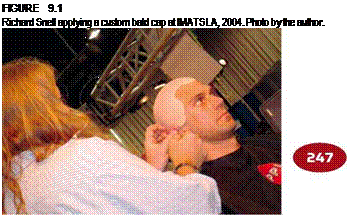Cap material comes in two varieties: acetone-based plastic (vinyl) and water-based plastic (vinyl). Michael Davy Film & TV Makeup makes and sells a water-based cap

plastic called Water-Melon® that can be dissolved with alcohol; New-Baldies® and Mould Life, both in the U. K., make acetone-based cap material that is also available in the U. S.
Plastic cap material can be used for a variety of applications, not the least of which is making bald caps; hence the name. It can also be used to seal molds or sculpture prior to molding and as an encapsulating layer for gel-filled appliances (GFAs). Cap material is an excellent encapsulating material for silicone GFAs because the edges can so easily be blended off instead of fighting them. Silicone will not dissolve away once it’s cured, but the cap material will, with either 99 percent IPA or acetone, though the less acetone comes in direct contact with skin, the better.
Cap plastic can also be used to make thin appliances to cover eyebrows or to make other small prosthetic appliances such as eye bags or built-up ears instead of using slush, or slip latex.
